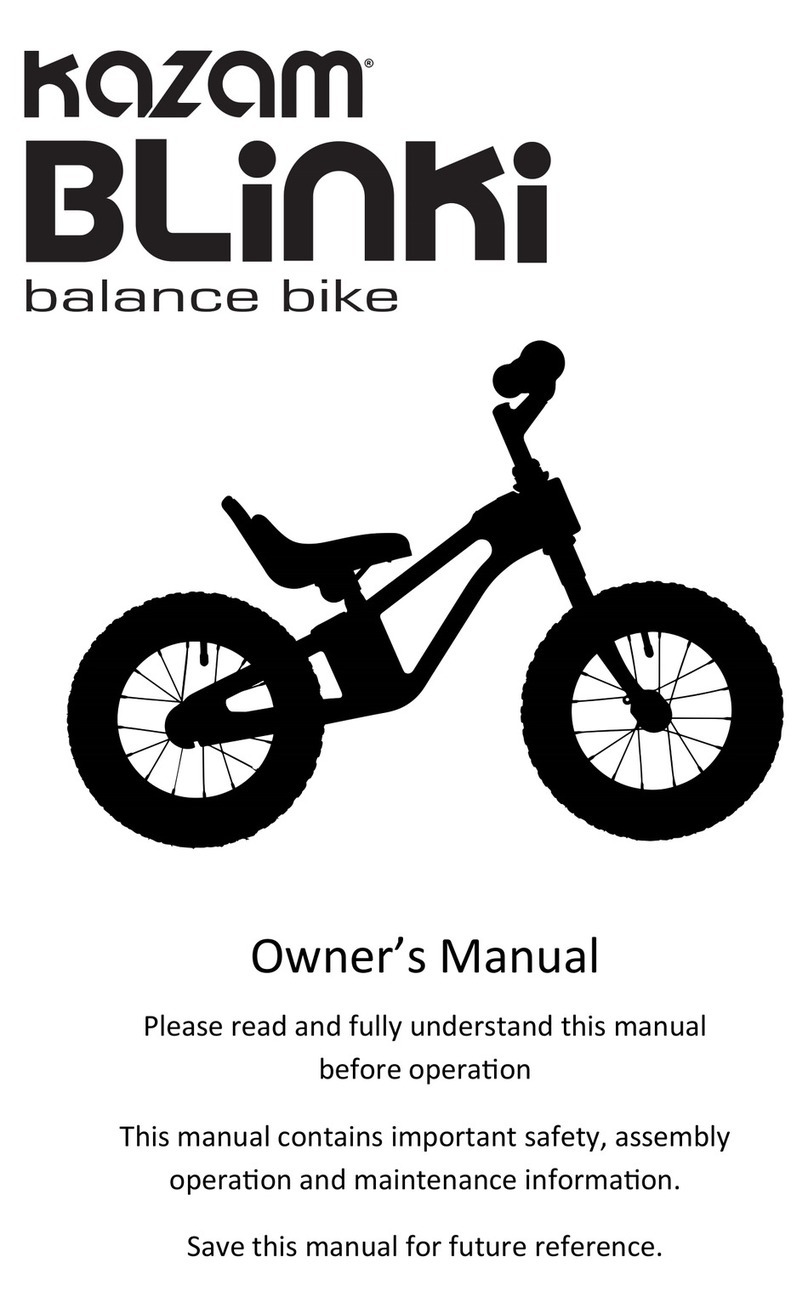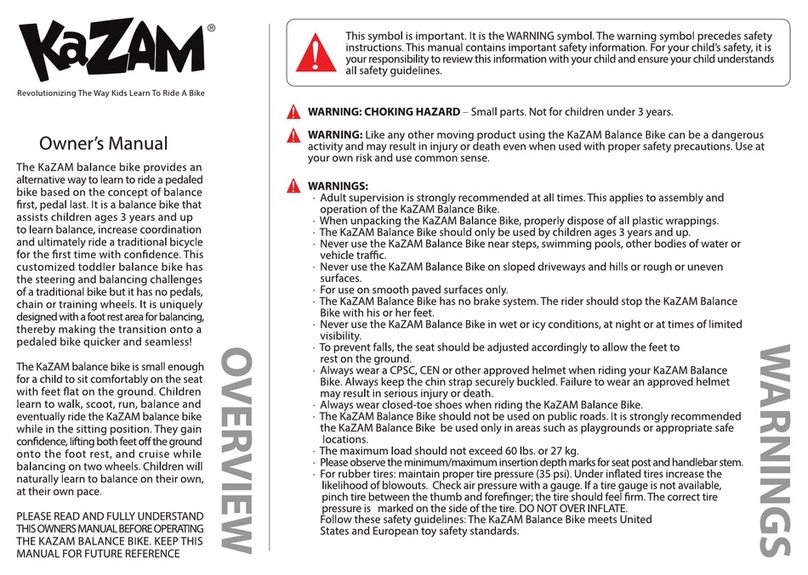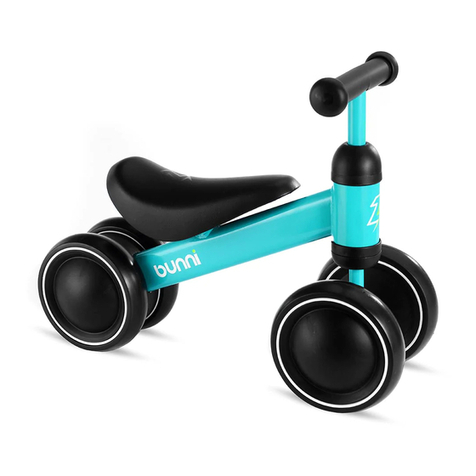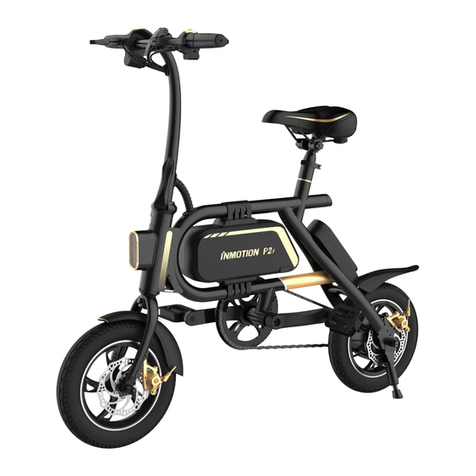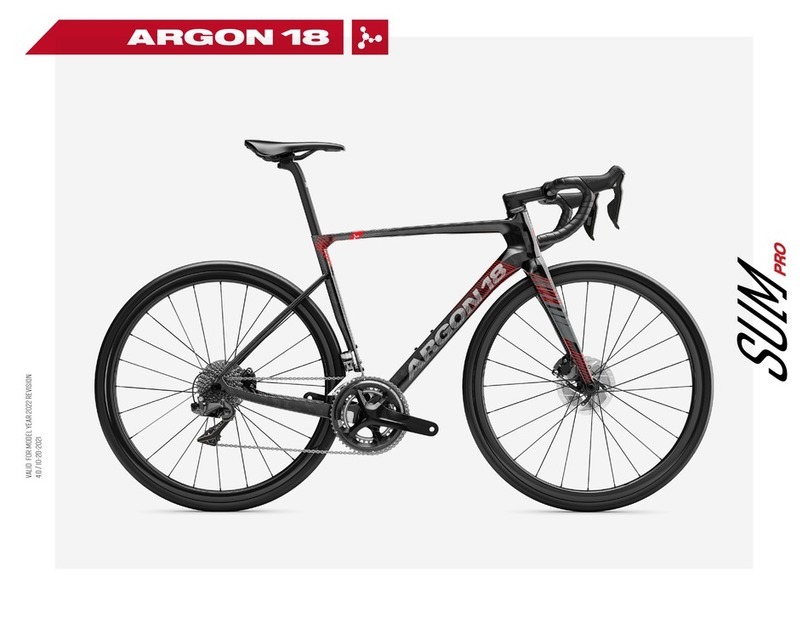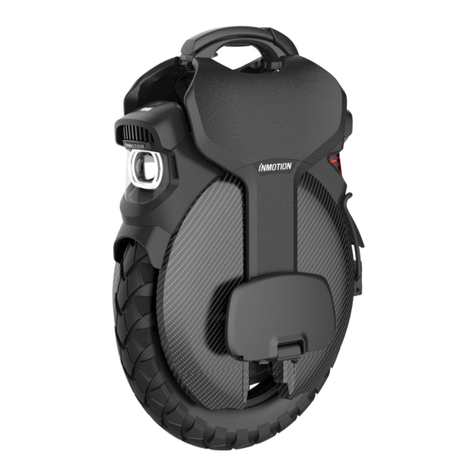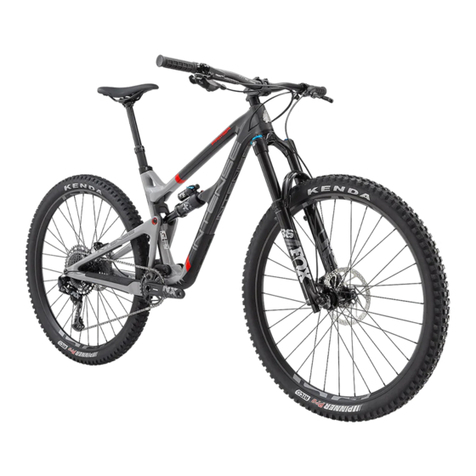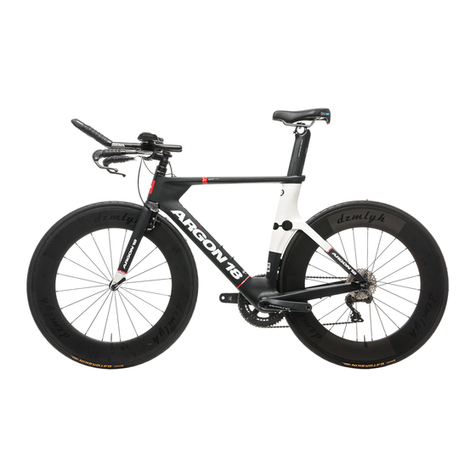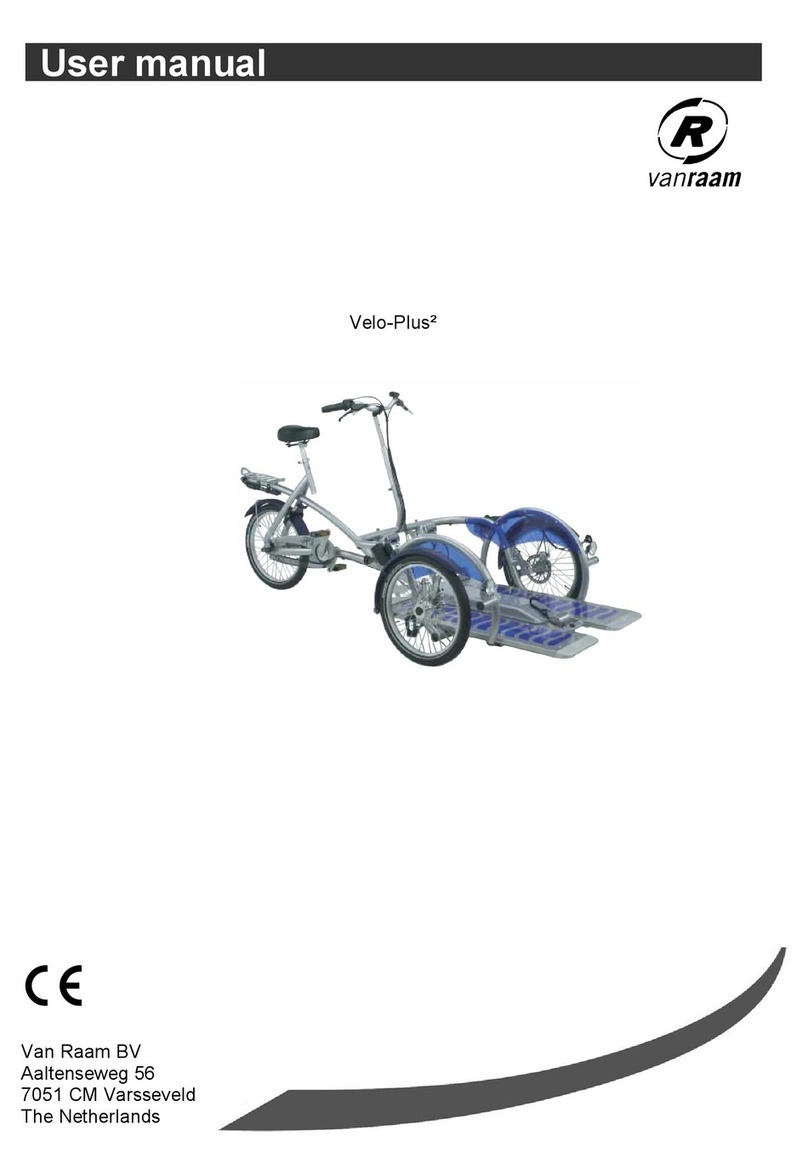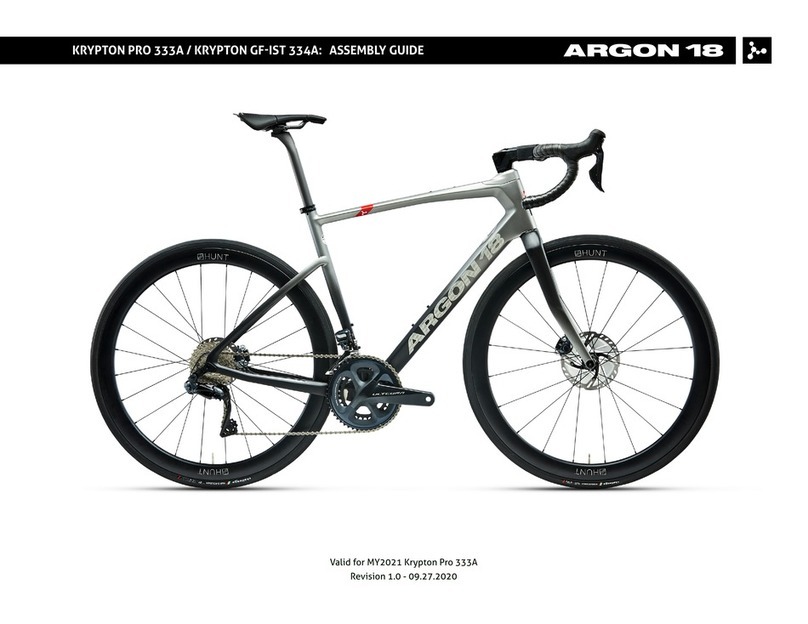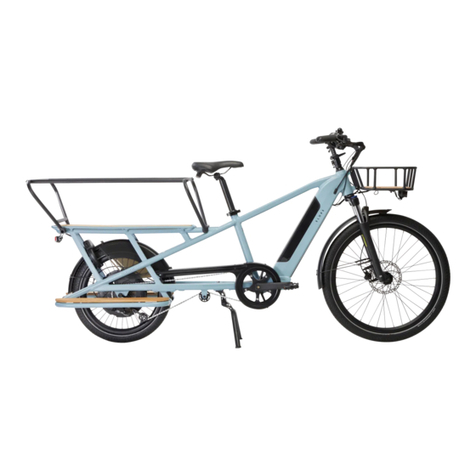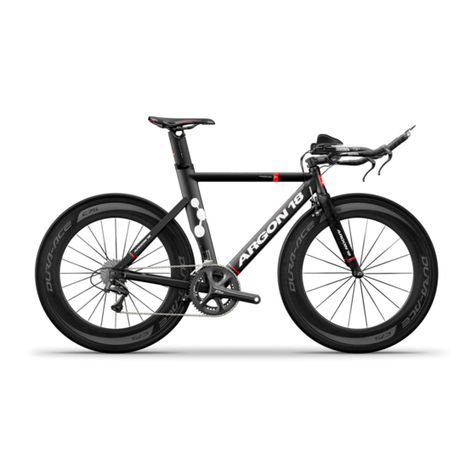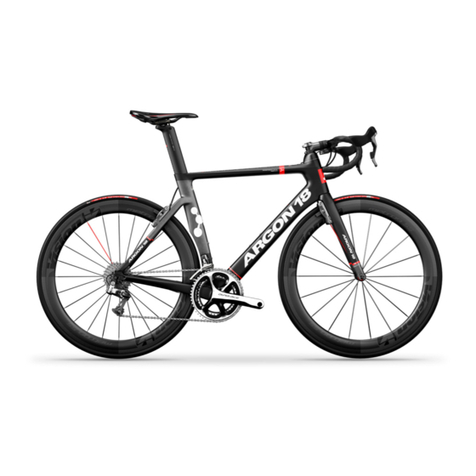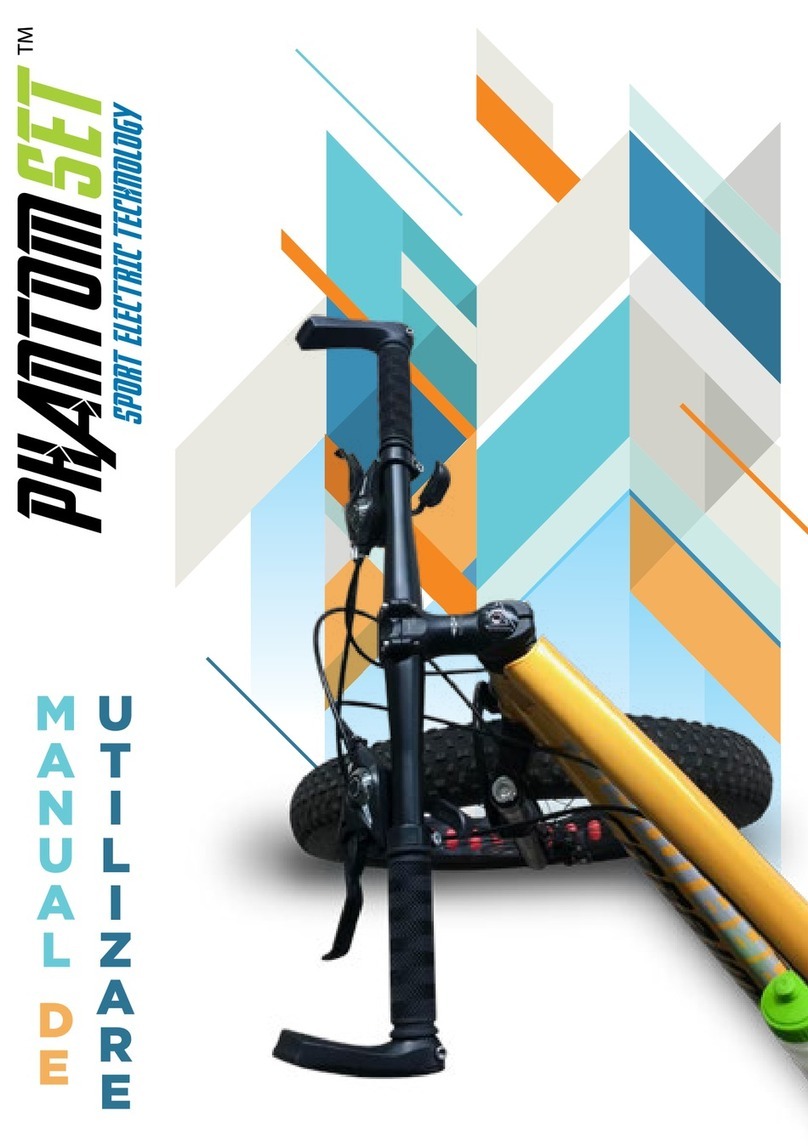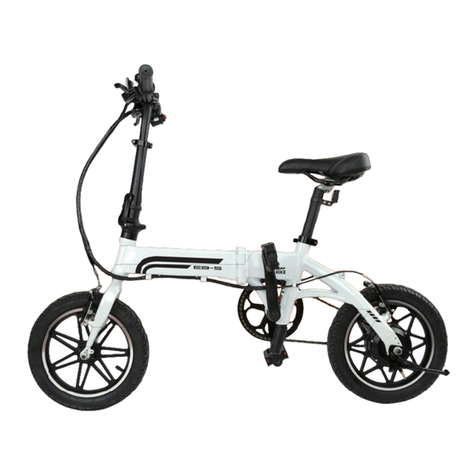KaZAM swoop balance User manual

1
KAZAM SWOOP BALANCE BIKE ASSEMBLY
THIS INSTRUCTION BOOKLET CONTAINS IMPORTANT SAFETY INFORMATION. PLEASE READ
AND KEEP FOR FUTURE REFERENCE.
FOR SERVICE ASSISTANCE CALL 757.452.3945
Monday - Friday 9:00 a.m. to 5:00 p.m. Eastern Standard Time
Congratulations on the purchase of your new Swoop Balance Bike! With proper assembly and
maintenance it will offer you years of enjoyable riding!
IMPORTANT:
Carefully read and follow this manual (and any other materials included with this bike) before riding.
Please retain this manual for future use. If this bike was purchased for a child, it is the responsibility of
the purchaser to verify that the bike has been properly assembled, and that the user has been properly
trained and instructed in use of the bike.
This manual is provided to assist you and is not intended to be a comprehensive manual covering all
aspects of maintaining and repairing your bicycle. The bicycle you have purchased is a complex piece of
equipment that must be properly assembled and maintained in order to be ridden safely. If you have
any doubts about the assembly or your ability to properly assemble and maintain the bicycle, you must
have it assembled and maintained by a professional bicycle mechanic.
DANGER! Failure to properly assemble and maintain your bicycle could result in serious injury
or death to the rider.
ALWAYS WEAR A PROPERLY FITTED HELMET WHEN YOU RIDE YOUR BICYCLE.
DO NOT RIDE AT NIGHT.

2
AVOID RIDING IN WET CONDITIONS.
RESPONSIBILITY OF THE OWNER!
IMPORTANT: Reading and following the information and instructions in this manual are essential to
your ability to ride safely.
1. It is the responsibility of the owner or in the case of a younger rider the parents of the rider to be
certain all assembly instructions have been followed, even if the bike has been assembled by the seller
or a professional assembly company.
2. Brakes are essential to safety. Be sure they are checked and working properly before each use.
Remember that any mechanical system changes condition during use and must be maintained and
checked before each use.
3. Rules for bicycle use (bicycle laws) vary from location to location so be certain the rider knows and
understands the rules that apply to bicycle usage in your area. Wearing a helmet and using lights and
reflectors are two examples of rules which may exist and which make sense as rider safety precautions
at all times.
4. Know how to operate the bicycle and all equipment on it before first use and be certain anyone else
allowed to use the bike knows how to properly and safely use the bike as well.
5. There are many different types of bicycles and often these types are designed for different uses.
Make sure you know what type of unit you have and do not exceed its service limitations. Be sure you
check and understand the bicycle classifications set forth below, including size of the unit that is proper
for the rider to insure good control during use. Do not overload a unit with a rider that is too heavy or
too large, and do not attempt to carry extra passengers, packages or loads on the bicycle. Do not
attempt to use street bikes for off road riding.
Children’s Bikes: (Max. weight of rider= 231 lbs./105kg). These bikes are intended for use by children in
safe areas with riding surfaces that are in good condition and free of traffic. Children must always ride
within their abilities under parental supervision and should wear a safety helmet and use other safety
equipment at all times. A parent should check the bike regularly and perform required maintenance.
NOTE. Carefully read this manual and follow instructions. Your bicycle may come with additional
instruction sheets that cover features unique to your bike. Please ensure that you read and become
familiar with their contents. Always wear a CPSC approved helmet when riding your bike. Familiarize
yourself with local and state traffic and use laws. Keep all materials which come with the bike for future
reference.
Any major service or adjustments on your bike should be carried out by a competent adult or
professional bike mechanic. If you wish to make adjustments yourself, this manual contains important
tips on how to do it. CAUTION: Any adjustments you make are entirely at your own risk. Do NOT use
your bike for freestyle and stunt riding, jumping or competitive events. Even if you are riding a mountain
bike, you should know that off-road use or any similar activities can be dangerous, and you are warned
that you assume the risk for personal injury, damages or loss incurred from such use. Do not ride your
bike when any part is damaged or not working properly. If you are unsure how to carry out repairs or

3
maintenance on your bike, it is vital that you promptly consult a local bike mechanic for professional
assistance and support.
WARNING: As with all mechanical components, the bicycle is subjected to wear and high stresses.
Different materials and components may react to wear or stress fatigue in different ways. If the
design life of a component has been exceeded, it may suddenly fail, possibly causing injuries to the
rider. Any form of crack, scratches or change of coloring in highly stressed areas indicate that the life
of the component has been reached and should be replaced.

4
Table of Content
Parts Identification Graphics.........................5
Before Riding.................................................8
Assembly Instructions...................................9
Maintenance.................................................13
Warranty.......................................................15
oALWAYS WEAR A PROPERLY FITTED
HELMET WHEN YOU RIDE YOUR
BICYCLE.
oDO NOT RIDE AT NIGHT.
oAVOID RIDING IN WET CONDITIONS.

5
IMPORTANT: Use this Diagram when reading this manual to help you understand directions and
instructions.

6
RULES OF THE ROAD
In the interest of safe cycling, make sure you read and understand the owner’s manual.
In this manual you will find DANGER, WARNING, CAUTION, IMPORTANT, and NOTE or NOTICE. These
are important signal words telling you to pay special attention to that text as rider safety is involved.
DANGER and WARNING: Pay special attention to these since failure to do so could result in serious
injury or death to the rider or others.
CAUTION: If not followed, these instructions could result in injury or mechanical failure or damage to
the bicycle.
NOTE or NOTICE or IMPORTANT: These specify something that is of special interest.
IMPORTANT: Before you ride this bicycle, read this RULES OF THE ROAD section and check that all parts
are installed and working as per this manual. If you understand how the bicycle operates, you will get
the best performance. When you read this instruction book, compare the illustrations to the bicycle.
Learn the location of all the parts and how they work. Keep this book for future reference.
CAUTION: Before you ride the bicycle, check the brake and other parts of the bike. Make sure all parts
are tightened, assembled correctly and working properly. Take your first ride in a large, open, level area.
If you have a problem, check the assembly instructions and follow the maintenance procedures in this
book. If you do not feel comfortable with your skills in assembling or adjusting the bike, please take it to
a professional bike repairman.
1. WARNING - ON AND OFF ROAD CONDITIONS: The condition of the riding surface is very important. If
the surface is wet, or has sand, leaves, small rocks or other loose debris on the surface where you plan
to ride, carefully decrease the speed of the bicycle and ride with extra caution. It will also take a longer
time and more distance to stop. Apply the brake earlier than normal and with less force, rear brake first
followed by the front brake if equipped, to help keep the bicycle from sliding or falling.
2. NOTICE: Most states require a full set of reflectors. Some state and local laws may require that your
bike be equipped with a warning device, such as a horn or bell and most states require a light. Do NOT
ride at night. Vision is quite limited at dawn, dusk and at night. If you must ride at night, take extra
precautions, use front and rear lights, wear flashers on your arms, wear light-colored clothing, and plan
your route to ride in well-lit areas.
3. Always wear shoes when riding a bicycle and avoid loose fitting clothes. Long sleeves, long pants,
gloves, eye protection, a good helmet, elbow and knee pads are recommended. Helmet use is required
by law in many states and is always a good idea.
4. CAUTION: WET WEATHER WARNING: Check your brakes frequently. The ability to stop is critical.
Roads are slippery in wet weather so avoid sharp turns and allow more distance for stopping. Brakes
may become less efficient when wet. Leaves, loose gravel and other debris on the road can also affect
stopping distance. If at all possible, do not ride in wet weather. Vision and control are impaired, creating
a greater risk of accidents and injury.
RULES OF THE ROAD continued

7
5. CAUTION: A bicycle rider’s best defense against accidents is to be alert to road conditions and traffic
in the area. Do not wear anything that restricts your vision or your hearing.
6. When riding, ALWAYS WEAR A CPSC APPROVED BIKE HELMET.
7. Obey all traffic regulations. Most traffic regulations apply to bike riders as well as automobile
operators. Observe all state and local traffic regulations, signs and signals. Check with your local police
station on bicycle licensing and inspection, and where it is legal to ride your bike.
8. Keep to the RIGHT SIDE. Follow the traffic flow in a straight line close to the curb. Watch out for
opening car doors and cars moving in and out of traffic. Use caution at intersections and keep both
hands on the handlebars.
9. Never carry passengers. This is dangerous and it makes the bicycle harder to control. Never carry
packages that can hinder your vision or control of the bike.
10. When riding in pairs or in larger groups, form a single line along the right side of the road. Set up a
sensible distance between riders. Don’t follow too closely.
11. Always be alert. Animals or people may dart in front of you. Give pedestrians the right-of-way. Don’t
ride too close to pedestrians, and don’t park your bicycle where it can get in the way of foot/vehicle
traffic.
12. Be careful at all intersections. Slow down and look both ways before crossing.
13. Use hand signals. Always let other drivers and pedestrians know what you are going to do. Signal 100
ft. before turning unless your hand is needed to control the bike.
14. WARNING: NIGHT TIME OPERATION: We do NOT recommend riding your bike at night. If you have
an emergency that requires you to ride at night, you must have proper lights and reflectors. NEVER ride
at night without a headlight, taillight, a white front reflector and red rear reflector.
15. Cover your stem, handlebar, and top tube with safety pads for additional protection.
16. Never hitch rides. Never hold onto moving vehicles while riding. Never stunt ride or jump on your
bike.
17. ON AND OFF ROAD OPERATION: Avoid the following road hazards: drain grates, pot holes, ruts, soft
road edges, gravel, leaves (especially when they are wet), uneven pavement, railroad crossings,
manhole covers, curbs, speed bumps, puddles, and debris. These road hazards can have an effect on
your riding and result in loss of control.

8
BEFORE RIDING:
Your new bicycle was assembled and tuned in the factory and then partially disassembled for shipping.
The following instructions will enable you to prepare your bicycle for years of enjoyable cycling. For
more details on inspection, lubrication, maintenance and adjustment of any area please refer to the
relevant sections in this manual. If you have questions about your ability to properly assemble this
bicycle, please consult a professional bicycle mechanic before riding.
5/6mm hex wrench
Torque wrench
Air pump & tire gauge to inflate tires
Bicycle lubricant or grease
6” adjustable wrench
Phillips & standard screwdrivers
A pair of pliers with cable cutting ability
BEFORE EVERY RIDE:
Just a minute spent before each ride can significantly improve your safety and the enjoyment of your
ride. So, each time before you ride make a habit of performing the following safety checks.
• Stand in front of the bicycle facing rearward and hold the front wheel securely between your legs. Try
to twist the handlebar and verify that it does not move. Then pull the handlebars up, trying to lift the
bike. There should be no movement.
• Try to push the front wheel from side to side and confirm that it feels tight and will not wobble. Lift
the front wheel up by the handlebars and strike it downward with the heel of your hand and confirm
that it is tight. Spin the front wheel and confirm that it does not wobble or contact the fork or brake
pads.
• Try to lift, push down on and twist the seat to confirm that it is tight.
• Make sure all reflectors are in position and not broken.
• Now, put on your bicycle safety helmet and enjoy your ride. Your safety is well worth it. Also, be sure
to read and follow the warnings and instructions in the Assembly, Maintenance and other sections of
this manual.

9
ASSEMBLING YOUR BIKE
PREPARATION: It is important that you read this owner’s manual before you start to assemble your
bicycle. WE RECOMMEND THAT YOU CONSULT A PROFESSIONAL BICYCLE MECHANIC IF YOU HAVE
DOUBTS OR CONCERNS AS TO YOUR ABILITY TO PROPERLY ASSEMBLE, REPAIR, OR MAINTAIN YOUR
BICYCLE. Remove all parts from the shipping carton. Check to make sure no parts are loose on the
bottom of the carton. Carefully remove the front wheel which is attached to the side of the bicycle for
shipping. Carefully remove all other packing material from the bicycle.
FRONT WHEEL
1. Remove the nuts, washers and wheel retainers from the front wheel axle, if
necessary. If these are not on the wheel axle, they will be included in the
hardware bag.
2. Slide the wheel onto the open ends of the fork. Slip an axle retainer onto each
end of the axle, and hook the retainers into the holes in the fork end. Loosely
install the washer onto each end of the axle (serrated end toward the retainer),
then install the hex nut. (Note: there may be a washer head nut in place of the
washer and hex nut).
3. Center the wheel in the fork and tighten the axle nuts securely, alternating
from one side to the other.
4. Spin the wheel to make sure that it is centered in the fork and does not wobble. If the wheel is not
centered, loosen the nuts and try again.
SEAT & SEAT POST ASSEMBLY (AS REQUIRED)
1. Loosen the seat clamp nuts.
2. Insert the top portion of the seat post into the seat clamp. Be sure the
seat post is completely inserted into the seat clamp and butted tightly
against the underside of the seat.
3. Tighten seat clamp nuts securely.
4. Insert the seat post (with seat attached) into the bike frame. Be sure
that the seat post is inserted past the minimum insertion line.
5. Tighten the seat post binder bolt securely at the desired height.
6. Adjust the angle of the seat so that the top of the seat is parallel to the
ground or comfortable to the rider.
7. Retighten the seat clamp nuts securely. Check for tightness by
attempting to twist the seat. If the seat is loose, be sure to tighten the
clamp nuts and binder bolt securely. Torque requirement is 15-20 ft. lbs.
THE SEATPOST “MINIMUM INSERTION” / “MAXIMUM HEIGHT” MARK SHOULD NOT BE VISIBLE
WHEN THE SEAT POST IS INSERTED INTO THE SEAT MAST OF THE BIKE. DO NOT RAISE THE SEAT
POST BEYOND THIS MARK. THE SEAT POST MAY BREAK CAUSING YOU TO LOSE CONTROL AND FALL.
ALWAYS CHECK TO MAKE SURE SEAT POST ADJUSTING MECHANISM IS TIGHTENED SECURELY BEFORE
RIDING. RIDING WITH AN IMPROPERLY TIGHTENED SEAT POST CAN ALLOW THE SEAT TO TURN OR
MOVE AND CAUSE THE RIDER TO LOSE CONTROL
SADDLE HEIGHT: In order to obtain the most comfortable riding position and offer the best possible
coasting efficiency, the seat height should be set correctly in relation to the rider’s leg length. The

10
correct saddle height should not allow leg strain from over-extension, and the hips should not rock from
side to side when coasting. The correct saddle height will allow the knee to be slightly bent. To obtain
maximum comfort, the rider should not over extend his or her reach when riding. There should be a
slight bend in the rider’s elbows.
SEAT & QUICK RELEASE SEAT POST ASSEMBLY
1. Loosen the seat clamp nuts.
2. Insert the top portion of the seat post into the seat clamp. Be sure the seat
post is completely inserted into the seat clamp and butted tightly against the
underside of the seat.
3. Tighten seat clamp nuts securely.
4. Insert the seat post (with seat attached) into the bike frame. Be sure that
the seat post is inserted past the Minimum Insertion Line.
5. Tighten the tension adjusting nut by hand and move the quick release lever
to the closed position. NOTE: Turning the tension adjusting nut clockwise
while keeping the lever from rotating reduces clamping force. Less than half a
turn of the tension adjusting nut can make the difference between safe
clamping force and unsafe clamping force. You should feel considerable
resistance while moving the lever. If not, re-open and retighten the lever,
then move it to the closed position so it is in line with the top tube of the
frame (as shown in the top illustration).
6. Adjust the angle of the seat so that the top of the seat is parallel to the ground or comfortable to the
rider.
7. Retighten the seat clamp nuts securely. Check for tightness by attempting to twist the seat. If the seat
is loose, be sure to tighten the clamp nuts and binder bolt securely. Torque requirement is 15-20 ft. lbs.
THE SEATPOST “MINIMUM INSERTION” / “MAXIMUM HEIGHT” MARK SHOULD NOT BE VISIBLE
WHEN THE SEAT POST IS INSERTED INTO THE SEAT MAST OF THE BIKE. DO NOT RAISE THE SEAT
POST BEYOND THIS MARK. THE SEAT POST MAY BREAK CAUSING YOU TO LOSE CONTROL AND FALL.
ALWAYS CHECK TO MAKE SURE SEAT POST ADJUSTING MECHANISM IS TIGHTENED SECURELY BEFORE
RIDING. RIDING WITH AN IMPROPERLY TIGHTENED SEAT POST CAN ALLOW THE SEAT TO TURN OR
MOVE AND CAUSE THE RIDER TO LOSE CONTROL AND FALL.
HANDLEBAR STEM
NOTE: the handlebar stem has been pre-assembled to the handlebar at the factory.
1. Remove the packing material and rotate the handlebar into an upright
position. Slightly loosen the clamp bolts to allow the handlebar to rotate
easily. After you have achieved a comfortable handlebar position,
proceed to tighten the clamp bolts to the required torque.
2. Insert the handlebar stem into the fork tube (head of the bike) with the
clamp portion of the stem towards the front of the bike. The stem must
be inserted far enough to hide the minimum insertion line marked on the
stem. If necessary, loosen the expander bolt to allow the stem to fit the
fork tube.

11
3. Place a drop of oil under the head of the expander bolt. Tighten the expander bolt just enough to hold
the stem in place.
4. Raise or lower the handlebar stem until you have reached the desired height for your child and then
position the handlebar so it is perpendicular (90 degrees) to the front wheel. Next, tighten the expander
bolt to the required torque. Be sure to have inserted the stem into the fork tube at least 2 1/2” (65mm),
making certain the minimum insertion line is not visible.
WARNING! ASSEMBLER IS CAUTIONED AGAINST THE DANGER OF DAMAGING THE HANDLEBAR
STEM ASSEMBLY AND POSSIBLE INJURY TO THE RIDER RESULTING FROM OVER TIGHTENING
THE EXPANDER BOLT AND EXPANDER WEDGE.
BAND BRAKE
BAND BRAKE QUICK ADJUSTMENT
Check the brakes on this bike regularly and adjust the brake when needed.
CAUTION: Never allow your child to ride the bike if the brake is not working
properly. If you do not feel comfortable in your ability to adjust the brake, we
recommend that you take your bike to a qualified bike mechanic for
adjustment.
1. Turn the 10mm adjuster bolt counter clockwise. In turning the adjuster bolt,
the brake cable will be pulled and will reduce the clearance between the lining
and the drum.
2. Press and release the brake lever 3 times to determine if the brake is holding.
3. Spin the wheel then press and hold brake lever, make sure that rear wheel stops.
WARNING: WHEN PRESSING THE BRAKE LEVER ENSURE THE LEVER DOES NOT HIT THE END OF
THE HANDLEBAR TO PREVENT MALFUNCTIONING OF THE BRAKE. IF THIS OCCURS, REPEAT
STEP 1. ENSURE THERE IS AT LEAST 3/4” CLEARANCE IN BETWEEN THE ENDS OF THE HANDLEBAR AND
THE BRAKE LEVER.
HAND BRAKE TORQUE REQUIREMENT 6-7 ft-lb (8-12 N-m)
TIRES AND TUBES
After assembling your bike, it will be necessary to inflate the tires. Check the sidewall of the tire for the
correct tire pressure (PSI) and inflate tires accordingly with a MANUAL BICYCLE PUMP. Improper
inflation is the biggest cause of tire failure. Due to the slightly porous nature of bicycle inner tubes, it
is normal for your bike tires to lose pressure over time. For this reason it is critically important to
maintain the proper tire inflation on your bike.
1. Your bicycle has been equipped with tires which the bicycle’s manufacturer felt were the best balance
of performance and value for the use for which the bike was intended. The tire size and pressure rating
are marked on the sidewall of the tire. CAUTION: Pencil type automotive tire gauges and gas station air
hose pressure settings can be inaccurate and should not be relied upon for consistent, accurate pressure
readings. Instead, use a high quality dial gauge.

12
WARNING: NEVER INFLATE A TIRE BEYOND THE MAXIMUM PRESSURE MARKED ON THE
TIRE’S SIDEWALL. EXCEEDING THE RECOMMENDED MAXIMUM PRESSURE MAY BLOW THE
TIRE OFF OF THE RIM, WHICH COULD CAUSE DAMAGE TO THE BIKE AND INJURY TO THE
RIDER AND OTHERS. THE BEST WAY TO INFLATE A BICYCLE TIRE TO THE CORRECT PRESSURE IS WITH A
BICYCLE PUMP. GAS STATION AIR HOSES MOVE A LARGE VOLUME OF AIR VERY RAPIDLY, AND WILL
RAISE THE PRESSURE IN YOUR TIRE VERY RAPIDLY.
WE DO NOT RECOMMEND USING GAS STATION AIR HOSES.
Tire pressure is given either as maximum pressure or as a pressure range. How a tire performs under
different terrain or weather conditions depends largely on tire pressure. Inflating the tire to near its
maximum recommended pressure gives the lowest rolling resistance; but also produces the harshest
ride. High pressures work best on smooth, dry pavement. Very low pressures, at the bottom of the
recommended pressure range, give the best performance on smooth, slick terrain such as hard-packed
clay, and on deep, loose surfaces such as deep, dry sand. Tire pressure that is too low for your weight
and the riding conditions can cause a puncture of the tube by allowing the tire to deform sufficiently to
pinch the inner tube between the rim and the riding surface.
Some special high-performance tires have unidirectional treads: their tread pattern is designed to work
better in one direction than in the other. The sidewall marking of a unidirectional tire will have an arrow
showing the correct rotation direction. If your bike has unidirectional tires, be sure that they are
mounted to rotate in the correct direction.
2. The tire valve allows air to enter the tire’s inner tube under pressure,
but doesn’t let it back out unless you want it to. There are primarily two
kinds of bicycle tube valves: The Schrader Valve and the Presta Valve.
The bicycle pump you use must have the fitting appropriate to the valve
stems on your bicycle. The Schrader is like the valve on a car tire, this is
the type of valve stem you should have on your bike. To inflate a Schrader valve tube, remove the valve
cap and push the air hose or pump fitting onto the end of the valve stem. To let air out of a Schrader
valve, depress the pin in the end of the valve stem with the end of a key or other appropriate object.
REFLECTORS
Your bike is supplied with one front (white) and one rear (red) reflector. These are an important safety
and legal requirement, and should remain securely fitted and in good condition at all times. Periodically,
inspect all reflectors, brackets and mounting hardware for signs of wear or damage. Replace
immediately if damage is found. Some bicycles will require you to install your reflectors onto your
bicycle. Please refer to the following section for instructions on all types of bicycle reflectors.
REAR REFLECTOR MOUNT ON SEAT POST / FRONT REFLECTOR MOUNT ON HANDLEBAR STEM
First attach the reflector to the bracket with the reflector screw. Next, remove the clamp screw and
open the clamping reflector bracket. Place clamping reflector bracket around the seat post. If the clamp
is too loose, insert the shim inside the clamp. Tighten the clamp screw to hold the reflector assembly in
place. Finally, adjust the reflector assembly in place and ensure that it is upright and facing away from
the bike.

13
CAUTION: Be sure the reflector is vertical to the ground. If the reflector is aimed up or down, oncoming
headlights may not reflect properly in the reflector.
MAINTENANCE & REPAIR
Correct routine maintenance of your new bike will ensure a longer life for your bike and a safer ride for
you. Every time you ride your bike, its condition changes. The more you ride, the more frequently
maintenance will be required. We recommend you spend a little time on regular maintenance tasks.
WHEELS AND TIRES
Wheel Inspection
It is most important that wheels are kept in top condition. Properly maintaining your bicycle’s wheels
will help braking performance and stability when riding. Be aware of the following potential problems:
• Dirty or greasy rims:
Caution: These can render your brakes ineffective. Do not clean them with oily or greasy materials.
When cleaning, use a clean rag or wash with soapy water, rinse and air dry. Don’t ride while they’re wet.
When lubricating your bicycle, don’t get oil on the rim braking surfaces.
• Wheels not straight:
Lift each wheel off the ground and spin them to see if they are crooked or out of true. If wheels are not
straight, they will need to be adjusted. This is quite difficult and is best left to a professional bicycle
mechanic.
• Broken or loose spokes:
Check that all spokes are tight and that none are missing or damaged.
Caution: Such damage can result in severe instability and possibly an accident if not corrected. Again,
spoke repairs are best handled by a mechanic.
• Loose hub bearings:
Lift each wheel off the ground and try to move the wheel from side to side. Caution: If there is
movement between the axle and the hub, do not ride the bicycle. Adjustment is required.
• Axle nuts: Check that these are tight before each ride.
• Quick release: Check that these are set to the closed position and are properly tensioned before each
ride.
Caution: Maintain the closed position and the correct adjustment. Failure to do so may result in serious
injury.
Tire Inspection
Tires must be maintained properly to ensure road holding and stability. Check the following areas:
Inflation: Ensure tires are inflated to the pressure indicated on the sidewall of the tire. Improper
inflation is the biggest cause of tire failure. Due to the slightly porous nature of bicycle inner tubes, it is
normal for your tires to lose pressure over time. For this reason, it is critically important to maintain the
proper tire inflation on your bike.

14
Caution: Use a hand or foot pump to inflate tires. NEVER inflate tires with an air compressor at a gas
station. This can cause the tubes to over inflate and blowout.
Bead Seating: When inflating or refitting the tire, make sure that the bead is properly seated in the rim.
Tread: Check that the tread shows no signs of excessive wear or flat spots, and that there are no cuts or
other damage.
Caution: Excessively worn or damaged tires should be replaced.
Valves: Make sure valve caps are fitted and that valves are free from dirt. A slow leak caused by the
entry of the dirt can lead to a flat tire, and possibly a dangerous situation.
Recommended Tire pressures:
The recommended pressure molded on the sidewall of your bicycle tires should match the following
chart. Use this as a general guide.
BMX: 35-50 p.s.i.
MTB: 40-65 p.s.i.
Road Touring: 70-90 p.s.i.
Road Racing: 110-125 p.s.i.
Hybrid/Cross bike: 60-100 p.s.i.
HEADSET
INSPECTION
The headset bearing adjustment should be checked every month. This is
important as it is the headset which locks the fork into the frame, and if
loose, can cause damage or result in an accident. While standing over the
frame top tube with both feet on the ground, apply the front brake firmly and
rock the bicycle back and forth; if you detect any looseness in the headset, it
will need adjustment. Check that the headset is not overly tight by slowly
rotating the fork to the right and left. If the fork tends to stick or bind at any
point, the bearings are too tight.
Note: If your bike is equipped with a thread less headset, please see a qualified specialist for repairs and
adjustments.
ADJUSTMENT
Loosen the headset top locknut or remove it completely along with the reflector bracket, if fitted. Turn
the adjusting cup clockwise until finger tight. Replace the lock washer or reflector bracket and tighten
the lock nut using a suitable wrench.
Note: Do not over tighten or bearing damage will occur.
WARNING! Always make sure that the headset is properly adjusted and the headset locknut is fully
tightened before riding.
WARNING! Over tightening the stem bolt or headset assembly may cause damage to the bicycle and/or
injury to the rider.

15
WARRANTY
This Warranty extends only to the original retail purchaser, who must produce proof of purchase in
order to validate any claim. This warranty is not transferable to anyone else.
What does this Warranty cover? This Limited Warranty covers all parts of the bicycle to be free of
defects in workmanship and materials.
What must you do to keep the Warranty in effect? This Warranty is effective only if:
- The bicycle is completely and correctly assembled.
- The bicycle is used under normal conditions for its intended purpose, by a person that properly fits and
is capable of controlling the bicycle.
- The bicycle receives all necessary maintenance and adjustments.
What is not covered by this Warranty? This warranty does not include labor and transportation charges.
The bicycle is designed for general transportation and recreational use only. This Warranty does not
cover normal wear and tear, paint, rust, normal maintenance items, personal injury, or any damage,
failure, or loss that is caused by accident such as a punctured inner tube, improper assembly,
maintenance, adjustment, storage, or use of the bicycle.
This Warranty will be void if the bicycle is ever:
- Used in any competitive sport.
- Used for stunt riding, jumping, aerobatics or similar activity.
- Installed with a motor or modified in any other way.
- Ridden by more than one person at a time.
- Rented or used for commercial purposes.
- Used in a manner contrary to the instructions in this Owner’s Manual. KaZAM will not be liable for
incidental or consequential loss or damage, due directly or indirectly from use of this product.
For how long does this Warranty last? The frame is warranted for the usable life of the bicycle. KaZAM
will replace the frame at no charge, should it fail in any weld point when the cycle has been used in a
normal manner, and determined by our inspection team. KaZAM will also replace the bicycle fork if it
should fail at any weld point. You must receive prior authorization from KaZAM Customer Service,
before returning any product or parts. All other components are warranted against defects for six
months from the date of purchase when properly assembled and used in a normal manner.
What will KaZAM do? We will replace, without charge to you, any frame, fork, or component found to
be defective by KaZAM.
CONSUMER MUST PAY ALL LABOR AND TRANSPORTATION CHARGES CONNECTED WITH THE REPAIR OR
WARRANTY WORK.
How do you receive service? Phone the Customer Service Department (9am - 5pm E.S.T.) at 1-757-452-
3945. All warranty claims should be made to KaZAM, PO Box 734, Virginia Beach, VA 23451 USA.
What rights do you have? This warranty gives you specific legal rights. You may also have other rights
which vary from State to State.
Table of contents
Other KaZAM Bicycle manuals


